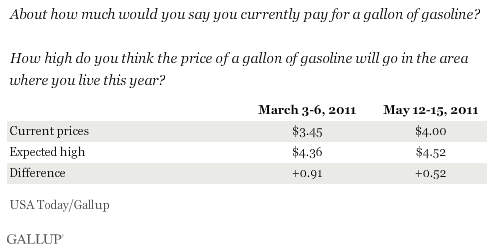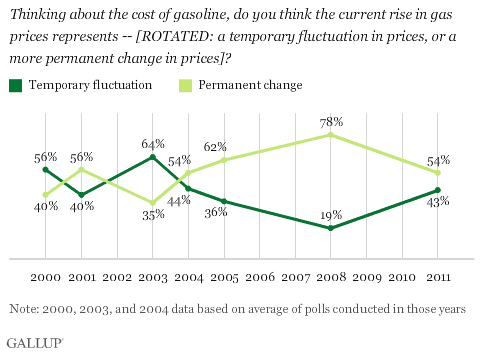PRINCETON, NJ -- Americans, who currently report paying an average price of $4 per gallon of gasoline, expect prices to continue to rise to an average of $4.52 this year. When ���۴�ýlast asked Americans about current and expected gas prices, in March, they were paying $3.45 per gallon and expected to pay up to $4.36. Thus, as gas prices have risen, so have Americans' expectations of how high they will rise, though the difference between current and expected prices is smaller now than in March.

The May 12-15 USA Today/���۴�ýpoll finds that 9% of Americans think gas prices have peaked, with 84% expecting them to increase further, based on an analysis of the difference between respondents' reported current and expected prices. That includes 27% of Americans who think gas prices will rise 75 cents or more in their local area before the year is out.
In March, fewer (1%) thought gas prices had peaked, while 76% correctly predicted prices would rise at least 50 cents from what they were paying at that time.

Southern residents report paying slightly less for gas on average than those living in other parts of the United States. Western residents expect prices to jump the most from what they are currently paying, to an average of $4.68 per gallon.

Americans Believe Price Increase Is Permanent
The majority of Americans think the higher prices are here to stay, with 54% saying the price increases represent a permanent change, compared with 43% who believe they are a temporary fluctuation. That is a more optimistic assessment than in 2008, the year gas prices set a record, when 78% thought the increases were permanent.
���۴�ýhas asked this question since 2000, and Americans have generally thought gas price increases were likely to be permanent in recent years. Prior to 2004, Americans were more inclined to see gas price hikes as temporary.

Americans in all four regions of the country think the price increases are permanent, ranging from 50% in the East to 59% in the West.
Democrats tilt toward thinking the increases are temporary, while Republicans and independents believe they are permanent.

Implications
The average price Americans report they are currently paying for gasoline has risen more than 50 cents in the last two months, and the public is bracing for even higher gas prices. If their predictions come true, gas prices will easily exceed the historical record high from 2008.
Two-thirds of Americans say current gas prices have caused them hardship, and a majority say to deal with the higher prices.
Should the high prices persist, many more Americans will likely follow suit and alter their behaviors to cope with the increased cost of gasoline.
Survey Methods
Results for this USA Today/���۴�ýpoll are based on telephone interviews conducted May 12-15, 2011, with a random sample of 1,024 adults, aged 18 and older, living in all 50 U.S. states and the District of Columbia.
For results based on the total sample of national adults, one can say with 95% confidence that the maximum margin of sampling error is ±4 percentage points.
Interviews are conducted with respondents on landline telephones and cellular phones, with interviews conducted in Spanish for respondents who are primarily Spanish-speaking. Each sample includes a minimum quota of 400 cell phone respondents and 600 landline respondents per 1,000 national adults, with additional minimum quotas among landline respondents for gender within region. Landline telephone numbers are chosen at random among listed telephone numbers. Cell phones numbers are selected using random digit dial methods. Landline respondents are chosen at random within each household on the basis of which member had the most recent birthday.
Samples are weighted by gender, age, race, Hispanic ethnicity, education, region, adults in the household, and phone status (cell phone-only/landline only/both, cell phone mostly, and having an unlisted landline number). Demographic weighting targets are based on the March 2010 Current Population Survey figures for the aged 18 and older non-institutionalized population living in U.S. telephone households. All reported margins of sampling error include the computed design effects for weighting and sample design.
In addition to sampling error, question wording and practical difficulties in conducting surveys can introduce error or bias into the findings of public opinion polls.
View methodology, full question results, and trend data.
For more details on Gallup's polling methodology, visit .
